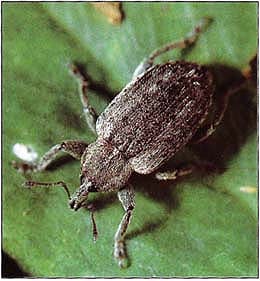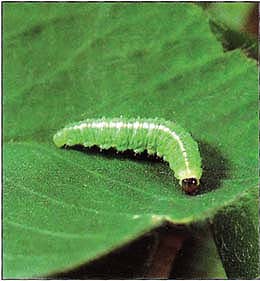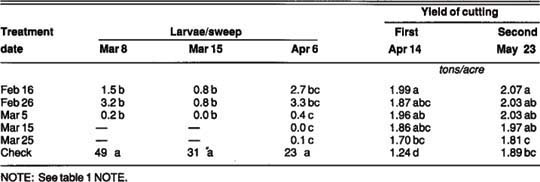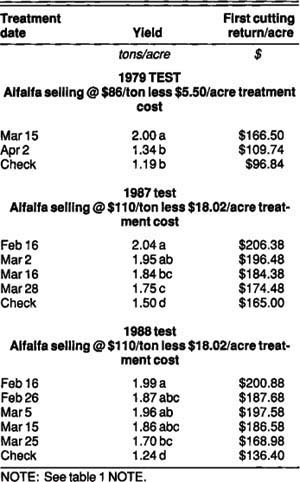All Issues
Treatment timing defined for Egyptian alfalfa weevil in the high desert
Publication Information
California Agriculture 44(1):18-20.
Published January 01, 1990
PDF | Citation | Permissions
Abstract
Profits were highest in Mojave Desert alfalfa when treatment for Egyptian alfalfa weevil was applied soon after winter plant regrowth began and leaf damage was present on new stems.
Full text
Two weevil species attack alfalfa in California: the alfalfa weevil, Hypera postica (Gyllenhal), and the Egyptian alfalfa weevil, H. brunneipennis (Boheman). Both were accidentally introduced into the United States.
The Egyptian alfalfa weevil arrived in the Imperial Valley of southern California from Arizona in 1950, and several alfalfa fields were severely damaged in 1952. In 1966, it was found in the southern San Joaquin Valley, and it now occurs through most alfalfa production areas in the state.
Approximately 30,000 acres of semi-winter-dormant alfalfa varieties are grown in the Mojave Desert. The first-cutting alfalfa in this area sells for a premium price and is fed to racing and riding horses, poultry, and dairy cattle.
A number of physical factors distinguish alfalfa production in the high desert from that in other areas of California. The altitude is 2,000 to 3,500 feet above sea level; winds moving from west to east at 15 to 30 miles per hour are common. Scattered mountain ranges can provide pockets of protection from cold winter winds sweeping across the desert.
The wide variation in geographic features and climate causes alfalfa to break winter dormancy from early February through mid-March. During this period, the alfalfa in most fields is not uniformly high enough for reliable sweep net sampling, but young Egyptian alfalfa weevil larvae can cause considerable plant damage and retard growth. We conducted chemical control trials in 1979, 1987, and 1988 to provide growers and pest control advisers with more reliable data on larval trends and help them avoid multiple treatments for Egyptian alfalfa weevil.
There were four replicates of the check plots and of the different chemical treatment dates in three field trials. Each fields test was arranged in a randomized block design. All insecticides were applied in 25 gallons of water per acre. Egyptian alfalfa weevil larvae were sampled with a standard sweep net.
1979 test
Penncap M (microencapsulated formulation of methyl parathion) was applied at 8 ounces active ingredient (AI) per acre on March 15 and in different plots on April 2 (table 1). All replicates were 0.88 acre. Twenty single sweep net samples of Egyptian alfalfa weevil larvae were taken in all replicates on each sampling date.
Alfalfa yields were measured on the first and second cuttings. Every bale in all plots was weighed with a scale and bale hooks attached to a hydraulic lift on a pickup truck.
The new alfalfa regrowth from winter dormancy was spotty on March 12. Samples taken in alfalfa tall enough for sweep net sampling gave an average of four larvae per sweep (table 1), mainly in the second and third larval stages (instars).
On April 1, damage by Egyptian alfalfa weevil was evident in the check plots and in those to be treated on April 2. The alfalfa was about 6 to 7 inches high. There was very little leaf damage in the plots treated on March 15, and the alfalfa was 7 to 8 inches high.
On April 10, the check reached 95 larvae per sweep. Most of the leaf tissue had been eaten and the damaged alfalfa was 8 to 10 inches high. Most of the larvae were in the third and fourth stages. We thought there was little information to be gained from these devastated plots, and they were treated on April 12 to reduce adult Egyptian alfalfa weevil reinvasion the next year.
The alfalfa was cut on May 2, and bale weights taken on May 9 (table 1). The March 15 treatment produced 2 tons per acre, which was significantly higher than the check and plots treated on April 2. There was no difference in yield between the check and the April 2 treatment, and both showed an obvious loss in hay quality. This alfalfa would not sell at a premium price.
1987 test
Carbofuran (Furadan) was applied at 1 pound AI per acre on all 1987 treatment dates (table 2). All replicates were 1.1 acre. Two of the treatment dates, February 16 and March 2, were before the alfalfa was tall enough for sweep net sampling.
When the alfalfa was about 6 inches high, 10 single sweep net samples were taken on each sampling date in the four replicates of the check and in all plots that were treated before the sampling date. Alfalfa yields were obtained by weighing every other bale from the first and second cuttings in all replicates.
On March 17, the alfalfa was 5 to 6 inches high and larval sampling began. Egyptian alfalfa weevil control was excellent after each treatment date (table 2). From April 13 on, however, there was no significant difference in larvae per sweep between the February 16 and March 2 treatments and the check. By April 28, larvae per sweep had started to decrease in the check and the two early treatments because of fourth instar pupation. The alfalfa was cut on May 4.
Yield was significantly lower in the check than in any of the treatments on the first cutting (table 2). There was no significant difference in yield between the February 16 and March 2 treatments. In general, yeilds decreased gradually as the treatment date extended into March. Yields from the second cutting (June 16) were significantly higher in the plots treated on February 16 and March 2 and 15 than in the check.
Mojave Desert alfalfa resumes growth in the spring, just as weevil feeding begins. Farm Advisor Steve Orloff checks plants for damage.
TABLE 1. Number of Egyptian alfalfa weevil (EAW) larvae per sweep and alfalfa yield, Palmdale, California, 1979
1988 test
Carbofuran was also applied at 1 pound AI per acre on all treatment dates in 1988 (table 3). All replicates were 10 feet wide and 90 feet long. Weevil larvae were sampled in the same manner as 1987.
Alfalfa yeilds were obtained on the first and second cuttings with a Carter Forage Plot Harvest. The net weight of the green, chopped alfalfa was taken in a 2.8- by 90- foot strip in the center of all replicates. A subsample of the chopped alfalfa was immediately taken from each replicate and placed in a plastic bag. Each wet-weight sample was spread over a separate paper sheet and dried to brittleness. The dry weights were recorded and adjusted to 14% moisture of field-baled alfalfa. The weights were then calculated to pounds per acre for all treatments.
The alfalfa was about 6 to 7 inches high on March 8. Ten single sweep net samples were taken in all replicates of the check and plots to be treated on March 15 and 25.
Weevil larvae gradually decreased in the check from March 8 to April 6 as fourth instars pupated. All treatments gave excellent weevil control.
In the first cutting on April 14, yields became significantly lower between the February 16 and March 25 treatment dates (table 3). All treatments had significantly higher yields than the check. In general, yield gradually decreased as the treatment date was delayed. The second cutting showed a significant yield decrease in the check and March 25 treatment compared with the February 16 treatment.
Conclusions
The 1979 yield data showed that Egyptian alfalfa weevil had severly damaged the alfalfa before the scheduled treatment on April 2. Even though the first cutting was a month away, on May 2, the alfalfa was unable to recover from the severe weevil damage. The yield from plots treated on April 2 was no different from untreated plots.
In 1987, plots treated on March 16 and 28 also suffered weevil damage before treatment and gave lower yields than those treated on February 16. Similar crop loss was evident in the 1988 test when treatment was delayed until March 25.
Alfalfa stands remain productive in the Mojave Desert for 6 to 8 years and sometimes longer, provided the stand is not severely damaged. More importantly, alfalfa growers are in business to make money. The monetary return from the various Egyptian alfalfa weevil treatment times for the 3 years of the trials is summarized in table 4. Effects of the weevil on the second cutting are not included.
Since there are no effective biological control agents of Egyptian alfalfa weevil, growers have to apply a pesticide or lose a good portion of the crop. Moreover, weevildamaged alfalfa will not sell at a premium price. Our results strongly suggest that chemical treatment for Egyptian alfalfa weevil in the Mojave Desert should be applied soon after the alfalfa regrowth begins and weevil damage is present on the new stems. On a calendar basis, this will vary from one field to another, depending on location, altitude, wind patterns, and winter temperature.











